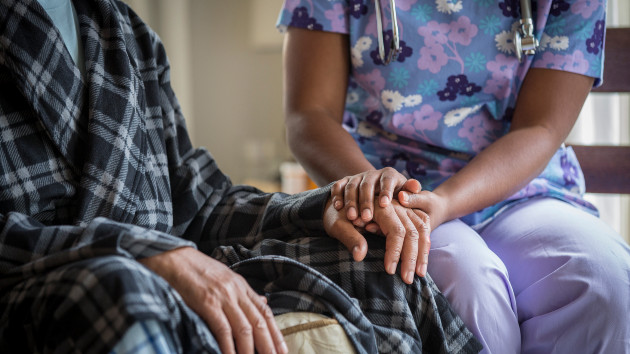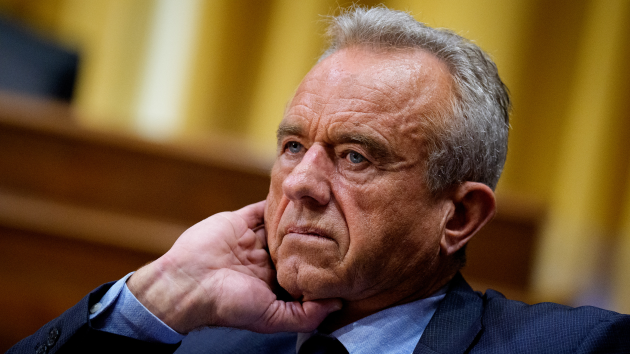Many nursing homes struggling to boost residents and staff members, experts say
Written by luck on March 10, 2022

(NEW YORK) — Despite being among the first eligible for COVID-19 booster shots, many nursing homes are struggling to boost residents and staff, experts say.
Nationally, about 72% of residents are boosted in each nursing home, according to data from the Center for Medicare & Medicaid Services.
But in about one-third of U.S. states, booster rates for residents are less than the national average among nursing homes, and three states have yet to crack an average of 60% of residents boosted in each facility.
Booster shots have been shown to be more protective against omicron and other COVID-19 variants. And nursing home residents continue to be among the most vulnerable people in terms of potential for severe illness and death — nearly 151,000 people in nursing homes have died since the beginning of the pandemic, CMS data shows.
While significantly higher than the 44% of Americans who have received a booster, experts say levels in nursing homes are lower than they’d like to see. Ideally, they should match the rate of vaccination — currently 87% of residents fully vaccinated per facility.
When it comes to booster uptake among nursing home staff members, the numbers are even lower than residents.
Only about 39% of staff members per facility have received booster shots, the CMS data shows, and more than half of states have rates below the national average of nursing homes.
“People may feel like, ‘Well, you got two shots and there’s no value’ or even ‘You had two shots and you had COVID already,'” Dr. Cindy Prins, an associate professor of epidemiology at the University of Florida College of Public Health and Health Professions, told ABC News. “I think we need to remember that our immunity can wane, especially in our older folks, and they need to keep getting that renewed protection and the booster will give them that.”
In three states, less than 60% of nursing residents are boosted on average
It’s well known that nursing home residents are among the highest at risk for severe COVID-19 complications due to their ages, likelihood of underlying conditions and the fact that they live in congregate settings.
“The other caveat to understand is that, in those that are over the age 65, sometimes it’s a little more difficult for them to develop responses to vaccines,” so getting a booster helps them mount an immune response, Dr. Katherine Baumgarten, medical director for infection prevention at Ochsner Health System in New Orleans, told ABC News.
Yet some nursing homes have been struggling to boost their residents. In three states — Florida, Arizona and Nevada — not even 60% of residents per facility on average have been boosted.
Florida has the lowest rate in the country at about 55%. By comparison, South Dakota has the highest rate at 87.56%.
The Florida Department of Health did not reply to ABC News’ request for comment on why rates are low.
“It’s absolutely something to be concerned about. That’s unacceptable,” Dr. David Grabowski, a professor of healthcare policy at Harvard Medical School, told ABC News. “With omicron and with potential new variants, having the most vulnerable individuals — these residents in nursing homes that have been the hardest hit by the pandemic — to have them not fully protected is really unfortunate.”
A February 2022 preprint study from France found nursing home residents who received a booster shot of the Pfizer-BioNTech vaccine had high levels of neutralizing antibodies against infection from the delta and omicron variants for at least three months.
Prins said she believes part of the reason booster uptake is low among the resident population in some states is because boosters were not promoted as much as the initial vaccines.
“In Florida, the initial vaccines were very much promoted for our older population,” she said. “It was very strongly put out there that seniors were first and they were going to get vaccinated.”
Prins continued, “But I didn’t see that same messaging with the booster. We haven’t placed the same emphasis on it at the state level that we did with that initial vaccine campaign for seniors.”
There are other theories for why the booster rate among nursing homes residents is lower than public health experts would like it to be.
Grabowski said the initial vaccine rollout was centralized, with the federal government partnering with CVS and Walgreens to distribute the shots to nursing homes.
“When it came time to do the booster rollout, this was really left up to the nursing homes to handle the booster clinics,” he said. “They do a flu vaccine every year for staff and residents and there was some thought that they could do this. Some did but there was also some really slow rollout that highlighted the haves and have nots across nursing homes.”
Grabowski continued, “Nursing homes were dealing with a lot during that period, and this was not something that was prioritized in those facilities and we’ve seen those low rates.”
Booster rollout has been slow among staff
Experts say it’s not just the elderly population in nursing homes who have been slow to get boosted — it’s also staff members.
According to CMS data, 12 states don’t even have an average of 30% of staff with boosters per facility. Florida is once again the state with the lowest rate at 24.52% while California has the highest rate at 68.58%.
Prins said it is possible the low booster rates for nursing home staff are partially due to many being ineligible for a third dose because they completed their vaccine series less than five months ago.
But she believes “that does not cover the extent of that lower booster rate” and said the low numbers are “concerning.”
“When you have this kind of facility, the virus gets brought in obviously, and it’s coming in with the people who are most mobile and most often there and that’s going to be your staff members,” Prins said. “[The low number] is absolutely a worry because that puts residents at high risk.”
Since the omicron wave, weekly cases and deaths in nursing homes have declined drastically. However, during the week ending Feb. 20, 2022, there were 620 resident deaths, the highest number since the week ending Jan. 2.
Mandates may be the only way to increase booster rates
The experts say there are a few ways to try and drive booster rates up in nursing homes.
Grabowski said for residents, it would help for the booster rollout to be more centralized with clinics set up by the federal government rather than left up to individual facilities.
However, he believes it will take mandates for booster rates among staff to rise dramatically. As of Tuesday, five states require COVID boosters for nursing home workers: California, Connecticut, Massachusetts, New Mexico and New York.
“The mandates are important here,” he said. ‘I think with boosters, with staff, it’s probably going to take mandates to make sure they go forward with the booster.”
The doctors add that, in addition, it could help to do sit-downs with small groups of nursing home staff to address their concerns and explain why boosters are beneficial. Baumgarten suggested this could include dispelling the ideas that boosters are ineffective or that they don’t reduce the risk of breakthrough infections.
“Nursing homes are a vulnerable population and we want to protect those who are vulnerable,” she said. “Everything that we can do to prevent them from being exposed or at risk for developing COVID important for us to do. If it’s simple enough to get a booster — which it is, they’re readily available, side effects are minimal — we should do that to help protect those around us.”
Copyright © 2022, ABC Audio. All rights reserved.





